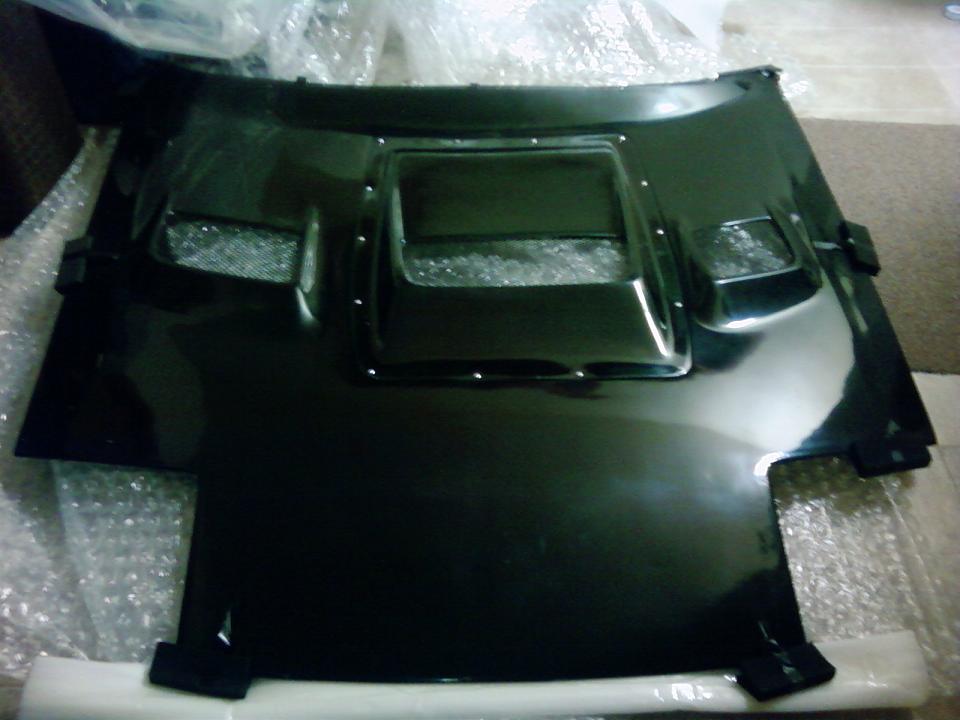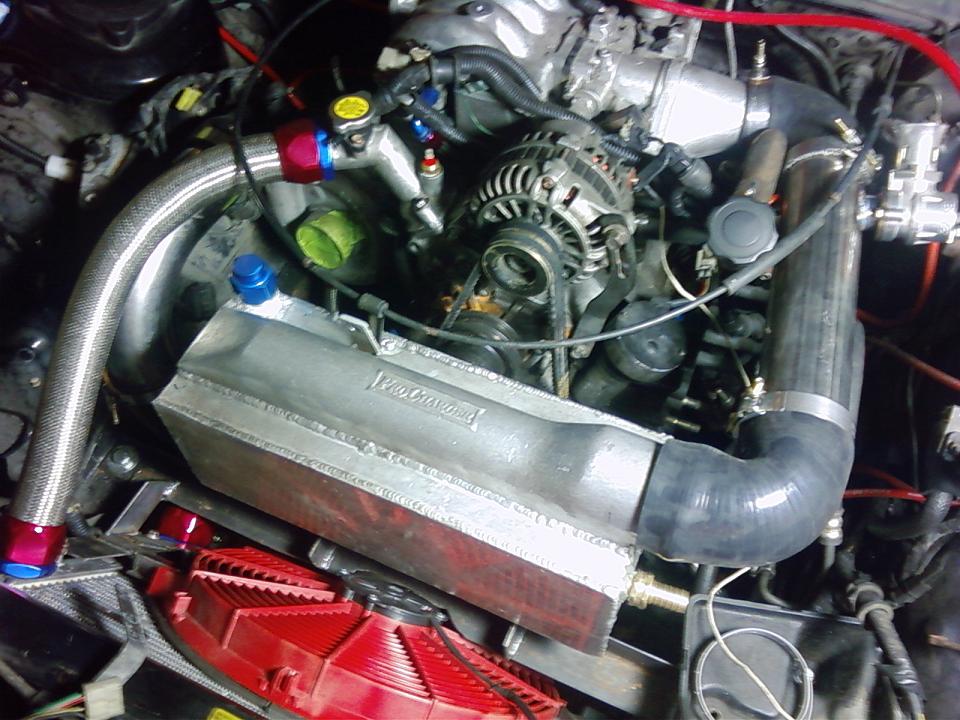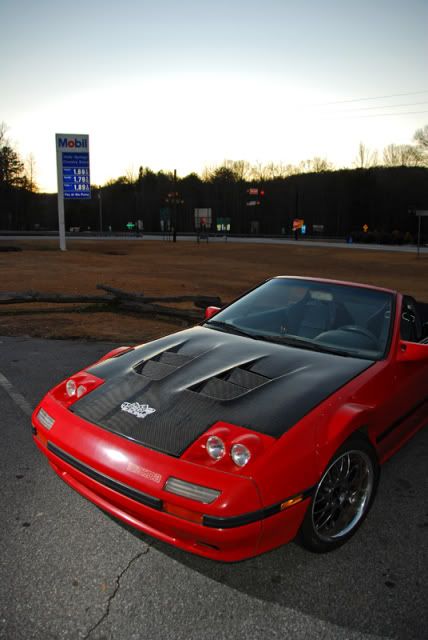looking 4 nice vented hood
#26
Are you implying that the original poster's mechanic is a dipshit ricer tard? I would never do such a thing because I am not a hater.
If you don't buy an obnoxious $3,000 CF hood for your car, then you can pretty much forget about running anything but the stock 13B engine. Everybody knows that while drift cars, show cars, and other ricers may have no hood vents, real race cars like Mandeville's winning 3-rotor car need hood vents in order to function.
If you don't buy an obnoxious $3,000 CF hood for your car, then you can pretty much forget about running anything but the stock 13B engine. Everybody knows that while drift cars, show cars, and other ricers may have no hood vents, real race cars like Mandeville's winning 3-rotor car need hood vents in order to function.
#27
Sorry should have explained myself, the hood is Tamon design (even has their URL tagged to the pic). The guy behind Tamon is the ex chief of design and development of aero parts for RE-Amemiya, so a lot of his stuff is confused for Amemiya.
Reasonably, sure it is a direct replacement, no modification needed

Reasonably, sure it is a direct replacement, no modification needed

If you don't buy an obnoxious $3,000 CF hood for your car, then you can pretty much forget about running anything but the stock 13B engine. Everybody knows that while drift cars, show cars, and other ricers may have no hood vents, real race cars like Mandeville's winning 3-rotor car need hood vents in order to function.
 Teal not even needed
Teal not even needed Seeing as how you have more aero knowledge than most on this forum combined, am I wrong in thinking that a hood like the atihun hood, would allow a small vacuum to form at speeds aiding in pulling air through an intercooler core if it was ducted to it?
#29
Not for you, but unfortunately it is needed for others.
Yes, plus the heat would tend to rise through the top of the hood due to natural convection, even when the car is not in motion. The outlets are supposed to be ducted from the heat exchanger rather than simple holes in the hood, and they should have a combined area of at least 115% of the inlet area which itself should be roughly 25% the area of the heat exchanger core. If you want to get fancy, you could add adjustable outlet louvers to optimize the flow for given speeds, but I think that is overly elaborate for a sports car's intercooler.
When the car is moving, ram air will force its way through the ducting system. The hood suction and natural convection are just an added plus that will not make a huge difference in my opinion.
LOL, I don't have a problem with one's personal preference in styling. However, I think it is sad when "professionals" push advertising hype on their customers, inadvertently or otherwise. I guess it would also be nice if more mechanics understood the concept of ducting.
When the car is moving, ram air will force its way through the ducting system. The hood suction and natural convection are just an added plus that will not make a huge difference in my opinion.
LOL, I don't have a problem with one's personal preference in styling. However, I think it is sad when "professionals" push advertising hype on their customers, inadvertently or otherwise. I guess it would also be nice if more mechanics understood the concept of ducting.
#30
Not for you, but unfortunately it is needed for others.
Yes, plus the heat would tend to rise through the top of the hood due to natural convection, even when the car is not in motion. The outlets are supposed to be ducted from the heat exchanger rather than simple holes in the hood, and they should have a combined area of at least 115% of the inlet area which itself should be roughly 25% the area of the heat exchanger core. If you want to get fancy, you could add adjustable outlet louvers to optimize the flow for given speeds, but I think that is overly elaborate for a sports car's intercooler.
When the car is moving, ram air will force its way through the ducting system. The hood suction and natural convection are just an added plus that will not make a huge difference in my opinion.
Yes, plus the heat would tend to rise through the top of the hood due to natural convection, even when the car is not in motion. The outlets are supposed to be ducted from the heat exchanger rather than simple holes in the hood, and they should have a combined area of at least 115% of the inlet area which itself should be roughly 25% the area of the heat exchanger core. If you want to get fancy, you could add adjustable outlet louvers to optimize the flow for given speeds, but I think that is overly elaborate for a sports car's intercooler.
When the car is moving, ram air will force its way through the ducting system. The hood suction and natural convection are just an added plus that will not make a huge difference in my opinion.
I agree that the moving louvers is a little over the top for this pj even though just about everything else has been over the top anyway.
This gem of a thread - https://www.rx7club.com/showthread.p...ighlight=d-max
I will never forget had, litterally, what looked like a hurricane symbol in the corner where the windshield met the hood that they claimed would pull air out from the engine bay. Total marketing bullshit but I'm sure alot of people bought it. Subsequently D-max took it down, shame too, I always got a kick out of it.
LOL, I don't have a problem with one's personal preference in styling. However, I think it is sad when "professionals" push advertising hype on their customers, inadvertently or otherwise. I guess it would also be nice if more mechanics understood the concept of ducting.

#31
Does this guy even need a vented hood? Seriously, they are functional on about 5% of cars who actually put them on. Just because he has a 20B doesn't mean he needs the hood.
And yah, that amemiya hood looks like it does need the matching bumper to be used.
And yah, that amemiya hood looks like it does need the matching bumper to be used.
#33
Actual numbers! Thanks. I'm actually going to measure the opening in the bumper and then the core itself and see how close I am. Then desing the vents to your suggestions. They will be ducted though and fuctional. The ducting is a double edged sword I think though. While it allows the i-cooler to work better, it does nothing for venting the radiant heat.
http://www.ch601.org/resources/cooling_systems2.htm
The orginal idea was to just cut into that and leave it relatively flat. Would a leading edge be beneficial there as well to create a small amount of vacuum or am I too close to the windshield at that point where it would force air into the bay at speeds or do really nothing ayway?
No, he needs a GOOD radiator (not some crappy Fluidyne drop-in or corroded junk yard radiator) with good ducting. One thing to keep in mind with a 20B is that the engine is much longer and may interfere with vents near the center of the hood. Also, a stock 20B-REW engine will not clear a stock FC hood, so some type of hood bulge (or gutted TII hood) is required unless the engine or its mounting position (including steering rack) is modified.
Most of them are just for looks, but you could still make the outlets functional by spending some time on some custom duct work.
#34
Even if it's not ducted to the coolers, it should help reduce the pressure in the engine bay and vent some air out (provided it's designed properly of course). This will be beneficial to cooling all by itself. Sure ducting is better, but it's not 100% necessary for it to help.
#35

Last edited by The Griffin; 12-13-08 at 10:49 PM.
#36
 I'm seriously going to put a request into the mods for you.
I'm seriously going to put a request into the mods for you.So you're saying
A) A vented hood only belongs on a race car
B) A little rain water is catosrophic if it lands on an intercooler
C) According to AE the vent needs to be roughy 29% of the size of the core, yeah, that requires a huge amount, say half the ******* hood to be cut out right there
D) We all know you envy me. It's flattering but please, if I catch you stalking me, I will stab you in the eye.
E) A dedicated race car owner and track junkie went to GREAT lengths to get this hood, I'm sure it's junk and completely useless.
#37
Optimal heat exchanger duct dimensions:
http://www.ch601.org/resources/cooling_systems2.htm
Aerodynamics speculation is rather tricky, but I think that you would want a lip or some type of outlet duct in order to keep ram air from shooting down the hole. I don't think it would be too close to the windshield.
http://www.ch601.org/resources/cooling_systems2.htm
Aerodynamics speculation is rather tricky, but I think that you would want a lip or some type of outlet duct in order to keep ram air from shooting down the hole. I don't think it would be too close to the windshield.
I'll prob take a few pics of the mocked up vents and play around with them some. The main vent for the intercooler is going to be a pretty damn close replication of the atihun hood though.
[quote=Evil Aviator;8797676]I'm not a professional because I have nothing to sell you, lol. Seriously though, brake ducting is outside of my realm, but I can look at it anyway.

The brake ducts aren't so much how they work but where they are located that is the cause for concern.
No, he needs a GOOD radiator (not some crappy Fluidyne drop-in or corroded junk yard radiator) with good ducting. One thing to keep in mind with a 20B is that the engine is much longer and may interfere with vents near the center of the hood. Also, a stock 20B-REW engine will not clear a stock FC hood, so some type of hood bulge (or gutted TII hood) is required unless the engine or its mounting position (including steering rack) is modified.
Most of them are just for looks, but you could still make the outlets functional by spending some time on some custom duct work.
Most of them are just for looks, but you could still make the outlets functional by spending some time on some custom duct work.
Even if it's not ducted to the coolers, it should help reduce the pressure in the engine bay and vent some air out (provided it's designed properly of course). This will be beneficial to cooling all by itself. Sure ducting is better, but it's not 100% necessary for it to help.
Someone has a great sig, something along the lines of one test result is worth more than a thousand expert opinions. I think it's RotaryGod actually.
#39
get an NA aluminum hood and mold this
http://jspec.com/typenvent.html
http://jspec.com/typenvent.html
#40
Yeah that one. I dig that one too but not as much as the atihun. I would rather see one vent that goes all the way across than a bunch lining the hood. It does retain some curves to it which I like, unlike the one below.
BTW - how old is that pic? I'm still paying $.80 more /gal.
Or save yourself an incredible amount of time cutting, glassing, riviting, bondoing, sanding, bondo'ing, sanding, bondo'ing sanding, glazing, sanding, glazing, sanding, surfacing, sanding, surfacing, sanding and buy Shines hood and save all that crap. I don't know what you make an hour but all that work isn't worth it to me when I can just go buy a hood that is virtually ready for paint rather than doing all that body work for something that still looks like complete and utter **** and isn't as functional as it could be.
BTW - how old is that pic? I'm still paying $.80 more /gal.
get an NA aluminum hood and mold this
http://jspec.com/typenvent.html
http://jspec.com/typenvent.html
#44
I'd love to see someone drive around with a dash mounted cam and a ton of tell-tales taped to a few vented hoods. You can bet your *** I'll be doing that.
Someone has a great sig, something along the lines of one test result is worth more than a thousand expert opinions. I think it's RotaryGod actually.
Someone has a great sig, something along the lines of one test result is worth more than a thousand expert opinions. I think it's RotaryGod actually.
While it's not an FC, they did go through that sort of development process and many people find that it helps with cooling on track. It's difficult to cool a turbo Miata on track with the small rad intake on the car, so an improvement in cooling will be very noticable.
#45
http://www.flyinmiata.com/projects/CF_hood.asp
While it's not an FC, they did go through that sort of development process and many people find that it helps with cooling on track. It's difficult to cool a turbo Miata on track with the small rad intake on the car, so an improvement in cooling will be very noticable.
While it's not an FC, they did go through that sort of development process and many people find that it helps with cooling on track. It's difficult to cool a turbo Miata on track with the small rad intake on the car, so an improvement in cooling will be very noticable.
That right there is some damn good reading. 3 things learned from that
1) While testing would be beneficial, I am in need of a vent for the intercooler, not just the engine bay so my vent placement is more limited than thiers

2) Looks like I'll be trying out a shitton of adhesives. I don't think I'll be welding on my perfect AL hood anymore
Originally Posted by Flying Miata
The first attempt. The welding caused the hood to buckle, so this one was scrapped for a fibreglass version. We were running out of time for the race.

3) Directed right at Mr Green -
Originally Posted by Flying Miata
A common question - what happens with the new hood when it rains? Keith's neighbours are a little worried about him now, but he proved that it has no effect on the car. The sprinkler ran for about 45 minutes and the car started right up.

#46
I really like the looks of this hood as well. It looks aggressive but not ricey.
As far as the number of vents is concerned, a bunch of smaller vents like that could actually be productive as the velocity in a smaller duct is generally higher. Then again it depends on how much air is actually flowing in. I not about to try and figure out the flow characteristics under the hood of an fc. I would imagine vent placement is one of the most important factors and if I remember right the middle of a smooth hood is a low pressure zone so I would imagine that would be the best spot.
Then again, is a venting really all that necessary? I know I'm not concerned.
#47
Rain would not be a problem unless it drained on a part that is adversely affected by water. On a parked car with ducting, rain and debris could collect on the back side of the heat exchanger, most likely accelerating the corrosion process.

Heat exits here.
Where, through the little cracks around that huge bar? 
Originally Posted by flyinmiata

Heat exits here.

#48
I saw that and had to laugh as well. Maybe they thought that the vacuum created in that particular spot would pull more flow around the bar than moving it a foot forward and getting more vent area but less vac

#49
Here is a pic of my new hood. I just got it Friday. It is sort of like a KS knockoff, but I don't think the center scoop would look good reversed what so ever on this one. I really wanted the panspeed hood, but I needed the vent(s) farther back to clear my liquid to air intercooler. You probably should consider the same fact, being that the longer 20b block may have similar clearance issues.
Sorry for quality, my only camera is the cellular variety

Obviously you see the 3 vents on top. Also notice the back of the hood curls up by the cowl slightly, where another vent runs the whole width of the hood. This is what I had to clear towards the front of the engine bay

It may be a little more aggressive of a hood than I had been looking for, but it will be super-functional for my setup, plus I scored it brand new for $180
Sorry for quality, my only camera is the cellular variety

Obviously you see the 3 vents on top. Also notice the back of the hood curls up by the cowl slightly, where another vent runs the whole width of the hood. This is what I had to clear towards the front of the engine bay

It may be a little more aggressive of a hood than I had been looking for, but it will be super-functional for my setup, plus I scored it brand new for $180
#50




